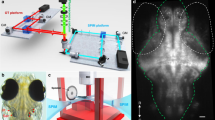Abstract
THE bilateral Mauthner neurons initiate the characteristic 'C-start'1,2 escape of fishes when they respond to underwater sounds accompanying attacks by predators3–6. Either of the two sound components, particle motion or pressure change can initiate Mauthner-mediated escape. Particle motion can be detected by inner ear sensory receptors and used for locating a sound source7, but sound pressure requires a transduction mechanism to stimulate the same receptors8–10. For fishes, sound pressure is a nondirec-tional scalar signal that is transduced by the swimbladder11,12. It might be assumed that particle motion, because of its directional nature, triggers Mauthner-initiated predator evasion2, but we demonstrate here that for acoustically mediated escape, sound pressure is the salient stimulus for activating the Mauthner neurons in fishes with swimbladders. This implies that displacement determines which of the two Mauthner neurons is activated, so that the fish turns away from the direction of the predatory attack.
This is a preview of subscription content, access via your institution
Access options
Subscribe to this journal
Receive 51 print issues and online access
$199.00 per year
only $3.90 per issue
Buy this article
- Purchase on Springer Link
- Instant access to full article PDF
Prices may be subject to local taxes which are calculated during checkout
Similar content being viewed by others
References
Zottoli, S. J. J. exp. Biol. 66, 243–254 (1977).
Eaton, R. C., DiDomenico, R. & Nissanov, J. J. Neurosci. 8, 2758–2768 (1988).
Blaxter, J. H. S., Gray, J. A. B. & Denton, E. J. J. mar. Biol. Ass. U.K. 61, 851–869 (1981).
Lauder, G. in Functional Vertebrate Morphology (eds Hildebrand, M., Bramble, D., Liem, K. & Wake, D.) 210–229 (Belknap, Cambridge, Massachusetts, 1985).
Webb, P. W. Can. J. Fish Aquat. Sci. 43, 763–771 (1986).
Nissanov, J. & Eaton, R. C. Am. Zool. 29, 103–121 (1989).
Fay, R. Science 225, 951–954 (1984).
Sand, O. & Enger, P. S. J. exp. Biol. 59, 405–414 (1973).
Fay, R. R. & Popper, A. N. J. exp. Biol. 62, 379–387 (1975).
Fay, R. R. in Hearing and Sound Communication in Fishes (eds Tavolga, W. N,, Popper, A. N. & Fay, R. R.) 189–221 (Springer-Verlag, New York, 1981).
Sand, O. & Hawkins, A. D. J. exp. Biol. 58, 797–820 (1973).
Popper, A. N. in Fish Neurobiology Vol. 1 (eds Northcutt, R. G. & Davis, R. E.) 125–178 (Michigan University Press, Ann Arbor, 1983).
Furukawa, T. & Ishii, Y. Jap. J. Physiol. 17, 572–588 (1967).
Fay, R. R. & Popper, A. N. J. exp. Biol. 61, 243–260 (1974).
Diamond, J. in Fish Physiology Vol. 5 (eds Hoar, W. S. & Randall, D. J.) 265–346 (Academic, New York, 1971).
Blaxter, J. H. S. & Hoss, D. E. J. mar. Biol. Ass. U.K. 61, 871–879 (1981).
Blaxter, J. H. S. & Fuiman, L. A. in The Mechanosensory Lateral Line: Neurobiology and Evolution (eds Coombs, S., Görner, P. & Münz, H.) 481–499 (Springer-Verlag, New York, 1989).
Eaton, R. C., Nissanov, J. & Wieland, C. M. J. comp. Physiol.A155, 813–820 (1984).
Korn, H. & Faber, D. S. Brain Res. 96, 342–348 (1975).
Fay, R. R. & Popper, A. N. in Comparative Studies of Hearing in Vertebrates (eds Popper, A. N. & Fay, R. R.) 3–42 (Springer-Verlag, New York, 1980).
Chapman, C. J. & Sand, O. Comp. Biochem. Physiol. 47A, 371–385 (1974).
Faber, D. S., Fetcho, J. R. & Korn, H. Ann. N. Y. Acad. Sci. 563, 11–33 (1989).
Furukawa, T. & Furshpan, E. J. J. Neurophysiol. 26, 140–176 (1963).
Moulton, J. M. & Dixon, R. H. in Marine Bio-Acoustics Vol. 2 (ed. Tavolga, W. N.) 187–232 (Pergamon, Oxford, 1967).
Eaton, R. C. & Kimmel, C. B. J. comp. Physiol. A 140, 337–342 (1980).
Fink, S. V. & Fink, W. L. Zool. J. Linn. Soc. 72, 297–353 (1981).
Zottoli, S. J. in Neurobiology of the Mauthner Cell (eds Faber, D. S. & Korn, H.) 13–45 (Raven, New York, 1978).
Tavolga, W. N. in Fish Physiology Vol. 5 (eds Hoar, W. S. & Randall, D. J.) 135–205 (Academic, New York, 1971).
Liem, K. F. Am. Zool. 28, 739–759 (1988).
Enger, P. in Lateral Line Detectors (ed. Cahn, P.) 239–248 (Indiana University Press, Bloomington, 1967).
Faber, D. S., Korn, H. & Lin, J-W. Brain. Behav. Evol. (in the press).
Author information
Authors and Affiliations
Rights and permissions
About this article
Cite this article
Canfield, J., Eaton, R. Swimbladder acoustic pressure transduction initiates Mauthner-mediated escape. Nature 347, 760–762 (1990). https://doi.org/10.1038/347760a0
Received:
Accepted:
Issue Date:
DOI: https://doi.org/10.1038/347760a0
This article is cited by
-
Behavioral pieces of neuroethological puzzles
Journal of Comparative Physiology A (2017)
-
Locomotor kinematics and behaviour in the escape response of European sea bass, Dicentrarchus labrax L., exposed to hypoxia
Marine Biology (2006)
Comments
By submitting a comment you agree to abide by our Terms and Community Guidelines. If you find something abusive or that does not comply with our terms or guidelines please flag it as inappropriate.



